Explore Montalcino's Medieval Charm and Savor Brunello Wine. Discover Italy's Treasured Village on Your Tuscan Journey.
Read more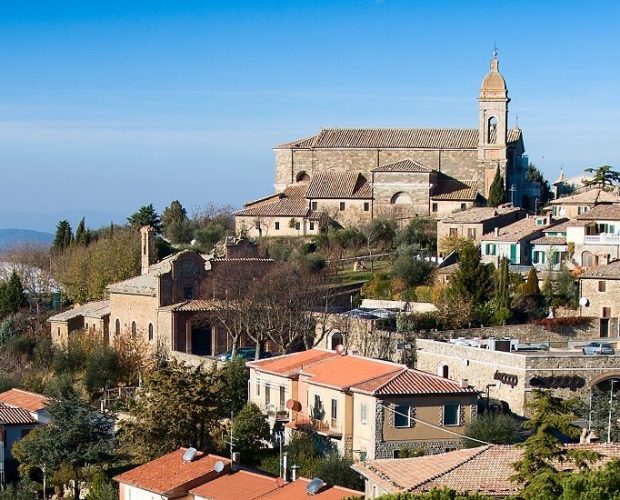
EXPLORE ALL OUR TUSCANY WINE REGION GUIDES
Last updated: April 3, 2024
Utterly charming and totally unspoiled, Montepulciano is a welcome antidote to the endless tourist crowds. Yet this tumbling hillside village is not just a destination for R&R: Montepulciano has produced exceptional red wines for centuries. The local drop is known as Vino Nobile di Montepulciano – popes, poets, proprietors, and politicians first made the region’s wines famous. Still, its popularity has endured thanks to its rich fruit, spicy flavors, and balanced acidity. It has Tuscany stamped all over it; few regions do food-friendly, digestible reds quite like the Italians.
However, Montepulciano has never enjoyed the global renown of its neighbor Montalcino or, indeed, Chianti Classico. Occasionally, the style is derided as “a decent value alternative to Chianti,” which is untrue. Despite the importance of Sangiovese, Vino Nobile di Montepulciano is not an understudy to the more famous Tuscan icons. It boasts a unique identity and heritage, with healthy innovation in these rolling hills. A poor relation it is not.
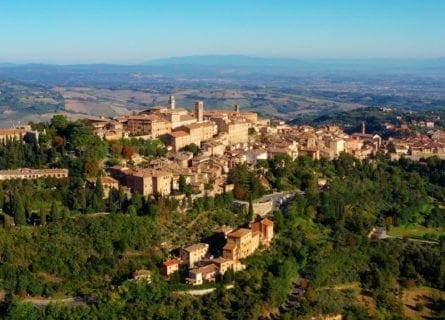
It is said that Montepulciano was founded by the Etruscan King Lars Porsena – the Etruscans colonized Tuscany in the 9th century BC, bringing wine, gladiatorial contests, and endless banqueting to the undulating landscape of central Italy. Even the might of Rome could not crush their spirits; after a prolonged conflict and resulting stalemate, the Romans took a more hands-off approach, granting them citizenship in 88 BC to manage their own affairs. This peace endured for over four centuries until the Western Roman Empire collapsed in AD 476.
The Lombards subsequently conquered Tuscany in the 6th century, and Montepulciano became a major center of religious worship. Yet the Lombards’ relationship with the Catholic Church remained fraught; many of their leaders retained a form of Germanic paganism and belief in multiple gods, rejecting Christian doctrine. Indeed, their rule was characterized by endless religious and ethnic conflicts that further alienated the church. In the 8th century, the papacy made a deal with the Frankish knight Charlemagne – he would remove the Lombards from Italy and, in return, rule as Emperor of the Holy Roman Empire. By 774, they had been banished for good.
Meanwhile, the first recorded mention of Montepulciano as a wine producer occurred in 789: the Church of San Silvestro was offered access to a vineyard in the hamlet of Lanciniano. This is very much in keeping with the traditions of the early Middle Ages when monasteries assumed responsibility for wine growing across Western Europe. In 1350, the first regulations governing the export of Montepulciano wines were cemented in writing. These sweetened red (and white) wines remained popular throughout the late Middle Ages, adored by the aristocracy and the religious establishment alike. However, the political landscape shifted constantly during this era; Montepulciano became a possession of the city of Florence, the birthplace of the Italian Renaissance. Today, Florence’s legendary Uffizi gallery houses some of the greatest artwork of the epoch, including Botticelli’s Birth of Venus and Raphael’s Madonna of the Goldfinch.
In the early 20th century, a pioneer called Adama Fanetti produced a Vino Nobile di Montepulciano style that we would recognize today. According to historical records, Fanetti’s wines were entered into a trade fair in Siena, earning the respect of Tancredi Biondi-Santi – one of the most famous names in Brunello di Montalcino. Fanetti remained a tireless promoter of Montepulciano wines throughout his life, laying the groundwork for creating the Vecchia Cantina di Montepulciano in 1937. This body was founded with the express purpose of spreading the renown of the area’s wines. Today, Fanetti’s successor continues to run the stunning Sant’Agnese Estate. It was a source of great family pride when the zone was awarded DOCG status in 1980.
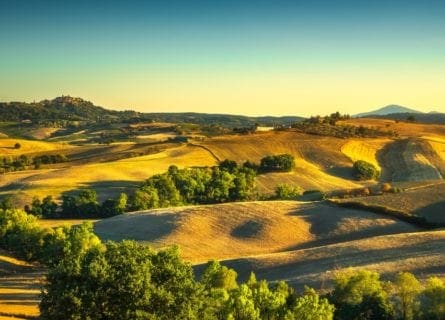
Montalcino’s neighbor to the east invites day trips from Siena – these sloping vineyards are less than 45 kilometers away from that handsome city. But despite a growing reputation – don’t worry, it’s a long way off Chianti in August – Montepulciano remains a tranquil hill town of great charm surrounded by vines, ancient wine estates, and cypress trees. Today, there are approximately 1,800 hectares under vine in the appellation, sandwiched between the Ocria and Chiana Rivers. The vineyards that flank Montepulciano itself, many of them planted in the sandy clay soils of gently sloping hills at around 600 meters above sea level, are sunny and well-drained, promoting a favorable maturation.
Yet there are many high-quality terroirs to be found across the zone, extending south to within touching distance of Chianciano. As in Montalcino, variances in altitude create a patchwork of mesoclimates that will heavily influence the final wine style. Many of the best sites are at 250-600 meters elevation, which helps moderate the summer heat ubiquitous in this sunny Mediterranean climate. Meanwhile, average rainfall hovers around the 740 mm per year mark. For that reason, many growers regard the steep slopes to the southeast of Montepulciano as the region’s unofficial ‘Grand Cru’ vineyard. Here, vines will slowly ripen small berries packed with fruit and acidity. In contrast, grapes cultivated at lower elevations will ripen relatively quickly, producing voluptuous (if occasionally flabby) expressions of Vino Nobile di Montepulciano.
The critical mass of vineyards in Montepulciano are planted to local clones of Sangiovese, called here Prugnolo Gentile, and some other indigenous and French grape varieties. Vino Nobile’s Prugnolo-based wines are often blended with up to 30 percent Canaiolo, Cabernet Sauvignon, and/or Merlot; white varieties can compose just 5% of the total blend. However, a growing number of reds are made with 100 percent Sangiovese.
Winemaking traditions in Montepulciano are a close facsimile of the regulations and practices governing Chianti Classico production. Like that region, Sangiovese can be legally blended with imported and/or native varieties, albeit the Vino Nobile di Montepulciano DOCG permits a maximum of 30 percent – 10 percent less than Chianti. Of course, some producers prefer 100%, while others believe that Merlot and Cabernet Sauvignon add much-needed color and body to Sangiovese wines. This ensures that no two bottles are entirely alike, one of the appellation’s most important USPs.
Historically, every Vino Nobile di Montepulciano bottle was aged in Italian botti (large wooden vats) for several years. This would help soften the austerity of Sangiovese’s notoriously astringent tannin without absorbing any new oak flavor. But times have changed, and minimum oak aging periods have been reduced to just one year in wood for both normal and Riserva versions. Shadowing the culture of Montalcino, French oak (not necessarily new) has become popular in certain quarters, in addition to shorter maceration times and fermentation in stainless steel at controlled temperatures; the result is a less chewy and more fruit-driven expression of Vino Nobile di Montepulciano.
Yet, with ever-varying blends and aging times (determined by winemaker preferences that go beyond minimum stipulations), it is not easy to describe a ‘typical’ Montepulciano red. But, we find that wines from this area tend to have a piquant, spicy edge to them, with rich fruit and firm tannins. Also revered are the Rossi di Montepulciano wines, made with the grapes of younger vineyards near Montepulciano. While aged for less time and generally less expensive than Vino Nobile, these wines are often just as exciting as the noble wines, thanks to their fruity and appealing youthful aroma.
Montepulciano has much to offer the Italian oenophile. There is a long and proud tradition of growing Sangiovese in these hills, blended to various degrees (or not) to fashion a high-quality red of great finesse and longevity. In blind tastings, the superior qualities of a good Vino Nobile often shine through; it is not uncommon for Vino Nobile di Montepulciano wines to receive higher scores than their counterparts from Montalcino. Yet many wine lovers are still minded to ask: why bother with Brunello’s less famous cousin? Why should I leave my comfort zone for this admittedly “pleasant” local red?
The answer is that Montepulciano is one of Tuscany’s best-value purchases: a sumptuous red that becomes wonderfully velvety with age. Moreover, we should add that producers tend to make wines that are more accessible in their youth than Montalcino – the pervading warmth of southern Tuscany leaves no shortage of expressive ripeness. Indeed, the best examples reveal the typical aroma and flavors of Sangiovese while toning down the tannins compared to the Brunellos made nearby and smoothing out the acidic notes of many Chianti Classicos.
It is an irresistible package when benchmarked against a young Brunello di Montalcino’s (sometimes) burly concentration and tannic force. The zone is also an important source of brilliant Super Tuscans who look to the Maremma for inspiration—led by the historic house of Avignonesi, a growing band of growers mix and match varieties to their hearts’ content. At the same time, several of them have branched out to the Cortona DOC zone to the immediate east. As you’d expect from one of Tuscany’s most dynamic regions, there is no lack of organic and biodynamic wine estates.
Still, many seasoned critics look to the past when finding pleasure in Montepulciano. They would argue that Tuscany’s greatest triumph – or at least a strong contender – is the luxurious sweet wines known as Vin Santo. At their best, Montepulciano’s take on this Tuscan delicacy is orange-colored, smoky, nutty, and richly delightful, made typically from Grechetto, Malvasia, and Trebbiano Toscano. The grapes are carefully dried in well-ventilated premises until December after the harvest to concentrate the sugars; fermentation and maturation take over three years for the basic version, extending to over eight for Vin Santo di Montepulciano Occio de Pernice (eye of the partridge). No cellar should be without this vinous treasure – a window into Tuscany’s past.
Malvasia Bianca, a historical grape from Greece, now thrives in Sicily and the Aeolian Islands, producing unique sweet wines.
Find out moreExperience Trebbiano Toscano's Renaissance: Aromatic & Fresh Bianco Toscana IGT from Petrolo. The Future of Italian White Wine
Find out moreDiscover Canaiolo: Tuscany's Wine Legacy & the 'Governo' Technique That Rescued Chianti in 19th-century winemaking.
Find out moreDiscover the irresistible allure of Cabernet Sauvignon—a worldwide favorite with robust, dark-bodied flavor. Unleash your wine journey today!
Find out moreSciaccarello, a key grape in Corsica, is used for red and rosé wines in the Ajaccio and Sartène appellations and IGP labels. It's known for its light colors, soft tannins, red fruit flavors, and peppery notes. Thriving in southwestern Corsica's granite soils, it's blended with Nielluccio for aromatic depth. Harvest timing is crucial to prevent high alcohol levels due to its late ripening. Originating in Tuscany, where it's called Mammolo, it adds violet aromas to Sangiovese-based wines.
Merlot is the most cultivated grape in Bordeaux and closely related to Cabernet Franc
Find out moreUnearthing Sangiovese: Italy's Ancient Grape with a Complex History. Explore its journey from Etruscans to modern-day excellence.
Find out moreIf you’re searching for the ideal gastronomic pairing, look no further than the southern expanse of the Montepulciano zone. The prized T-bone steaks (“bistecca alla Fiorentina”) from cattle raised in the valley have no equal in Tuscany: the depth of flavor is incredible and profound. Ideally, enjoy a charcoal-cooked steak alongside a mature vintage of Vino Nobile Riserva just as the sun sets over the valley. Afterward, ask your waiter for some pecorino or ravaggiolo – some of Italy’s finest cheeses, hard and butter soft, are made in the Val di Chiana.
A Guide to the Gastronomy and Cuisine of Tuscany: Read more

Explore Montalcino's Medieval Charm and Savor Brunello Wine. Discover Italy's Treasured Village on Your Tuscan Journey.
Read more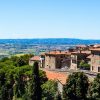
Visit Cortona, Tuscany's hilltop gem with Etruscan roots, Renaissance art, and stunning Val di Chiana views, as seen in 'Under the Tuscan Sun'.
Read more
Explore Florence: A Renaissance marvel with stunning art, architecture, and a rich winemaking legacy, in the heart of Tuscany.
Read more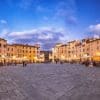
Explore Lucca, a tranquil Tuscan town with 16th-century walls, charming lanes, rich musical history, and picturesque biking trails.
Read more
Discover Pienza's Renaissance Charm and Rich History in the Heart of Tuscany's Val d'Orcia. Explore Etruscan Roots, Renaissance Architecture, and Timeless Beauty.
Read more
Discover Pisa's Rich History and La Dolce Vita - Beyond the Leaning Tower. Explore a Cultural Gem in Northern Tuscany.
Read more
Explore San Gimignano, Tuscany's 'medieval Manhattan', with historic towers, charming streets, fine wines, and a rich, romantic history.
Read more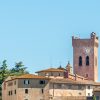
Discover San Miniato, the Tuscan gem: medieval allure, renowned truffle festival, diverse cultural theater, and panoramic valley views.
Read more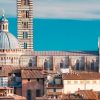
Discover Siena, a Tuscan gem with rich history, stunning medieval architecture, cultural wonders, and proximity to Italy's famous wine regions.
Read more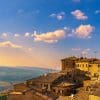
Volterra, 'Little Rome': A Tuscan gem where Etruscan artistry, medieval charm, and Renaissance beauty blend in a picturesque setting.
Read moreIf you would like us to customize an exclusive luxury tour, contact us and let us know your travel plans. We offer luxury food and wine tours for private groups of a minimum two guests. In addition, all of our private, chauffeured tours are available year-round upon request.

